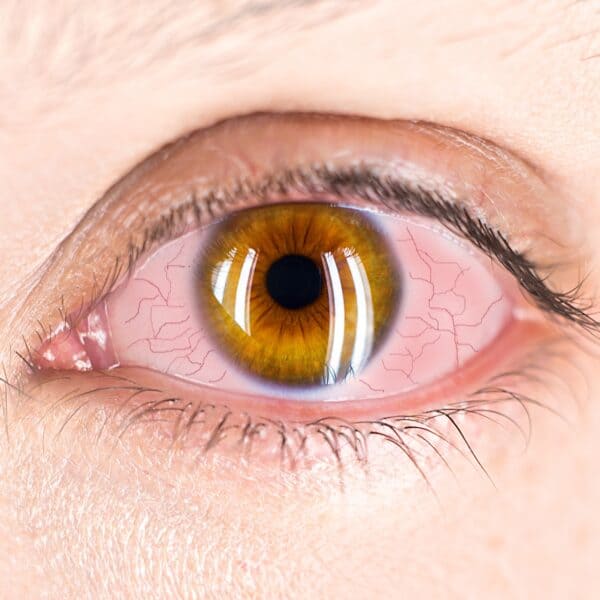
‘Tis the Season for “Pink Eye”
December 12, 2023

‘Tis the season for sniffles, sore throats, and the dreaded… “PINK EYE!”

Conjunctivitis (AKA “Pink Eye”)
Pink eye is a generic term for conjunctivitis, which is swelling of the conjunctiva of the eye. The conjunctiva is a thin, clear layer that covers the sclera (white part of the eye) and extends onto the inner eyelid. There are many causes of a pink-tinted or red eye, but most people immediately think of the contagious, infectious form of conjunctivitis. Since we’re in the midst of the stereotypical season of “pink eye”, we will primarily focus this blog on the infectious type.
Signs and Symptoms of Conjunctivitis
– Pink or red appearance to the white part of the affected eye(s)
– Excessive tearing and/or discharge
– Ocular irritation or grittiness
– Eyelids crusted shut upon waking up
– Itching or burning
– Photophobia (light sensitivity)
Causes of Conjunctivitis
The contagious forms of conjunctivitis are caused by an infection. Upper respiratory infections and various cold strains can easily be transferred to the eyes. Infectious conjunctivitis can be divided into two main categories: bacterial and viral.
Bacterial conjunctivitis is usually from staphylococcal or streptococcal bacteria from one’s own skin or respiratory system. Touching your eyes with unclean hands (especially children playing with shared toys) or wearing someone else’s eye makeup or contact lenses can also cause a bacterial infection.
Viral conjunctivitis is usually from the common cold or adenovirus and is generally more contagious than its bacterial counterpart. It can be contracted from exposure to viral particles in the air from someone coughing or sneezing with an upper respiratory cold. Viral conjunctivitis can also be spread from an infected individual to their own eyes if particles from the nose or throat get transferred near the eyes.
Other non-infectious causes of ocular redness include allergies, contact lens abuse, toxicity (or chemical-related), and uveitis.
Diagnosis and Treatment of Conjunctivitis
Diagnosing conjunctivitis is strongly determined through the history of symptoms and presentation, in addition to examining the eyes with light under magnification. Without professional examination, conjunctivitis can be incorrectly diagnosed in many people.
The treatment for viral conjunctivitis is similar to that of the common cold; It is self-resolving and needs time to go away on its own. Since antibiotics do not work for viral infections, the focus shifts to alleviating the eye symptoms rather than treating the actual infection. Cool compresses relieve swelling and irritation of the conjunctiva. Preservative-free artificial tears can help decrease irritation as well. In some severe cases, steroids are used to lessen the swelling, however, this will not shorten the course of the infection.
Bacterial conjunctivitis is treated with antibiotic drops or ointment. Artificial tears can also help alleviate any irritation. It is important to use the antibiotics for the prescribed amount of time to prevent the infection from returning. Even if you feel better after a couple days, continue using the antibiotics as prescribed.
Prevention of Conjunctivitis
Follow these steps to minimize your chances of getting an infectious form of conjunctivitis:
– Avoid touching your eyes (and face in general)
– Wash hands often, especially if touching shared objects with others
– Don’t share a washcloth or towel with others
– Throw away contaminated eye cosmetics and don’t share makeup with others
As Doctors of Optometry, we specialize in eyes! Please don’t forget about us if you or your child gets “pink eye.” Having the correct diagnosis and treatment is the most effective way to kick the irritated eye. Call our office to schedule!